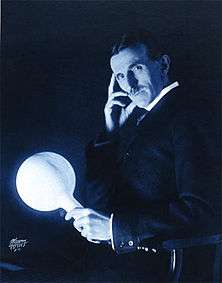Telegeodynamics
Telegeodynamics is an electromechanical earth-resonance concept for underground seismic exploration proposed by Nikola Tesla.[1]
Description
Tesla designed this system for use in prospecting and discerning the location of underground mineral structures through the transmission of mechanical energy through the subsurface. Data from reflected and refracted signals can be analyzed to deduce the location and characteristics of underground formations. Additional non-mechanical responses to the initial acoustic impulses may also be detectable using instruments that measure various electrical and magnetic parameters. Such predicted responses would--at least--take the form of induced electric and magnetic fields, telluric currents, and changes in earth conductivity.
The electromechanical oscillator was originally designed as a source of isochronous (that is to say, frequency stable), alternating electric current used with both wireless transmitting and receiving apparatus. In dynamical system theory an oscillator is called isochronous if the frequency is independent of its amplitude. An electromechanical device runs at the same rate regardless of changes in its drive force, so it maintains a constant frequency (hz).
See also
References
- ↑ The underlying principles are discussed in Tesla's paper, "Relative merits of the Lucas method of prospecting by detonations of explosive compounds and of the Tesla method of prospecting by isochronous oscillations theoretically considered" (ed., available in the book, Nikola Tesla's Teleforce & Telegeodynamics Proposals, Leland Anderson and Gary Peterson, editors, 21st Century Books, 1998, ISBN 0-9636012-8-8
Further reading
- Journal Il Nuovo Cimento C, On a new general theory of earthquakes. Italian Physical Society, ISSN 1124-1896. Issue Volume 11, Number 2 / March, 1988 doi:10.1007/BF02561733 Pages 209-217 SpringerLink Date Thursday, February 08, 2007
